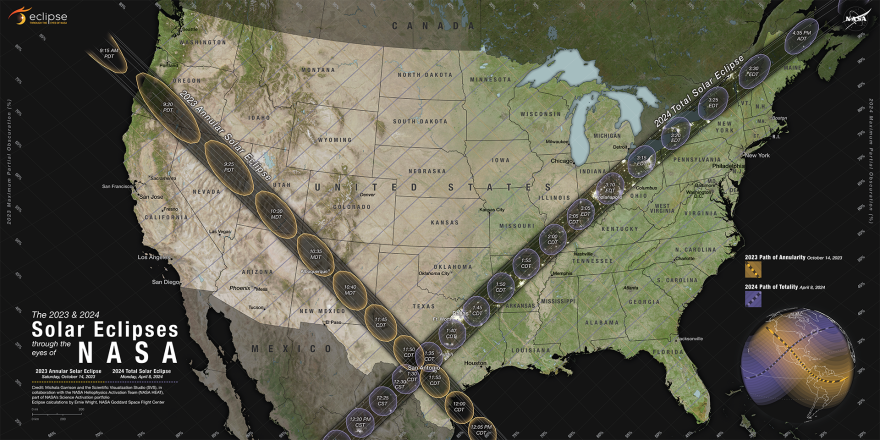Folks in the Austin area will have a prime vantage point to catch a solar eclipse April 8. It's the first time in nearly 150 years a total eclipse will darken the state's skies.
Some Central Texas residents will be luckier than others when it comes to how long they'll be able to see the moon fully obscuring the sun, or its "totality."
Austinites in the city will be in the moon’s shadow for nearly 2 minutes, depending on where they are. You’ll get twice as much time in total darkness if you travel northwest.

The last time a total solar eclipse passed through Texas was in 1878 and, barring groundbreaking scientific breakthroughs, you and I likely won't be around when the next one takes place in Austin. With that in mind, now is the time to make sure you've got all your ducks in a row.

Pick your eclipse-watching spot
First, figure out where you want to be for the eclipse. A deciding factor might be how long the moon covers the sun.
4+ minutes of darkness
Burnet, Llano and Marble Falls will be closest to the eclipse’s path of totality. That means folks there will experience some of the longest times in the shadow cast by the moon.
If you’re able to make it out to Lampasas or the Buchanan Dam, you’re looking at nearly 4 and 1/2 minutes in the dark, the longest eclipse duration across the entire country.
3+ minutes of darkness
Folks in Georgetown, Cedar Park or Leander can expect to be bathed in the shadows for at least 3 minutes. The same goes for people in San Saba and Temple, who’ll see about 3 minutes and 45 seconds' worth of totality.
1+ minute of darkness
Dripping Springs residents will get just less than 3 minutes of shadow exposure, and those in Pflugerville can expect just a bit more than 2 minutes' worth. Here at the KUT Newsroom, we’re expecting about 1 minute and 54 seconds of eclipse totality.
Check out what to expect where you are here.
Bastrop, Caldwell and Lee counties are just outside the eclipse’s path, so folks there who want to experience totality (and you should, if possible), should make plans to head west of I-35.
Prepare for a long day
While Central Texans may have won the celestial lottery to see the 2024 eclipse, we won’t be alone in witnessing the event. Hundreds of thousands of visitors are expected to descend on Austin and the surrounding areas for a chance at the best view.
If you're planning to leave home for a better view, lock down that reservation sooner rather than later, and get there before the madness of eclipse day.
With the path of totality running through more rural areas of Central Texas, county officials have been prepping for emergency response, traffic control and sanitation (porta potties will be aplenty).
The farther you get into the Hill Country, the fewer lanes of traffic you’re likely to encounter. That means more congestion is possible as people head back to their home bases post-eclipse.
Some school districts closest to the path of totality — Dripping Springs, Burnet and Liberty Hill, among others — have canceled class in anticipation of the increase in visitors.
Day trippers should bring food, water and toiletries in the event that a mass exodus post-eclipse causes a traffic jam. Though you may have plenty of experience handling the daily backups on MoPac or I-35, you’ll want to make sure you’ve got a full tank of gas — and maybe even some extra.
One report conducted after the total eclipse in 2017 found traffic in the U.S. remained high throughout the day after the eclipse.
In Central Texas, the partial eclipse is expected to start around 12:20 p.m., with the moon fully eclipsing the sun around 1:30 p.m. If you’re planning on traveling to a spot with the longest totality and going home afterward, you could be looking at spending multiple hours in your car.
Get your gear now
You'll be able to look at the eclipse with your naked eyes for only a few minutes during totality. But for most of the afternoon, you’ll need a pair of solar-safe glasses. No, your favorite pair of sunnies will not do the trick. No, stacking multiple pairs of glasses is not a safe alternative.
The glasses must meet international safety standards to view the sun. There are a few ways to confirm your viewers are safe to watch the eclipse.
Don’t put off getting your glasses until the last minute. Eclipse glasses were in short supply in the weeks leading up to the 2017 eclipse. And if you get a pair soon, you can use them to take in the annular solar eclipse that’ll pass to our southwest on Oct. 14.






